Application of X-ray Powder Diffraction and Inductively Coupled Plasma-Mass Spectrometry in Study on Mineralogical Characteristics and Significance of Wolframite from Xihuashan Tungsten Deposit, Jiangxi Province
-
摘要: 目前针对江西大型黑钨矿石英脉型钨矿床西华山的黑钨矿矿物学特征及指示意义研究较少.本文利用X射线粉晶衍射分析和电感耦合等离子体质谱分析技术对黑钨矿晶体结构、化学成分特征及空间变化规律开展研究.获得黑钨矿晶胞参数为a0=0.477 nm, b0=0.573 nm, c0=0.498 nm, β=90°21', 属于锰钨铁矿, 与前人得出的黑钨矿晶胞参数略有不同, 代表不同元素对铁锰的类质同象替代.主要化学成分WO3、FeO、MnO的含量在空间上具有一定的变化规律, 反映了成矿物质的运移特征.微量元素Sc、Y、Nb、Ta在垂向含量变化大, 说明矿液运移具有复杂性.稀土总量ΣREEs较高(397.16×10-6~1071.11×10-6), 具有强烈的Eu负异常, 具重稀土富集左倾的"躺椅式"球粒陨石标准化配分模式.将西华山、盘古山、淘锡坑、大吉山4个典型矿床的黑钨矿稀土元素特征进行对比, 反映产在花岗岩内接触带的黑钨矿的稀土总量(ΣREEs)相对最高, 分馏最明显; 产在花岗岩内及其外接触带的黑钨矿的稀土总量(ΣREEs)相对较低, 分馏程度最不明显; 而产在花岗岩外接触带的黑钨矿的稀土总量(ΣREEs)有高有低, 分馏程度有强有弱.因此, 黑钨矿的化学成分变化特征, 可以有效地指示成矿物质空间运移特征、物质来源和矿床成因.
-
关键词:
- 西华山钨矿床 /
- 黑钨矿 /
- 矿物学 /
- X射线粉晶衍射法 /
- 电感耦合等离子体质谱法
Abstract: The Xihuashan tungsten deposit is a typical large quartz-vein type tungsten deposit with systematical study, but researches on chemical composition and spatial distribution regulation of wolframite are relatively less. Based on microscopic mineralogy, the crystal structure, chemical composition, REEs and trace elements, geochemical characteristics of wolframite selected from different levels of Xihuashan tungsten deposit were studied using X-ray Powder Diffraction and Inductively Coupled Plasma-Mass Spectrometry. The obtained lattice parameters of a0(0.477nm), b0(0.573 nm), c0(0.498 nm), β (90°21') showed that the wolframite belongs to manganese tungsten ore. It is lightly different from lattice parameters of previous studies, which is caused primarily by isomorphous substituting on Fe and Mn. The chemical components of wolframite contain mainly WO3, FeO and MnO, showing some regularity in space, indicating migration features of ore-forming material. The wolframite also contains multiple kinds of trace elements. Sc, Y, Nb and Ta show dynamic changes of content in the vertical direction, which reflect complexity of ore fluid migration. The chondrite-standardized REEs distribution patterns are characterized by left-leaning shapes with high ΣREEs (397.16×10-6-1071.11×10-6), relatively heavy REEs enrichment and strong Eu negative anomaly. By comparing the REEs characteristics of wolframite from four typical tungsten deposits including Xihuashan, Pangushan, Taoxikeng and Dajishan, the results show that the wolframite in the inner contact zone of the granite body is characterized by relatively high ΣREEs with obvious REEs fractionation. Wolframite in the inner granite body and outer contact zone is characterized by relatively low ΣREEs with unobvious REEs fractionation. Wolframite in the outer contact zone of the granite body is characterized by large changes of ΣREEs and REEs contents and fractionation. Wolframite composition characteristics can not only be used to indicate migration features of ore-forming material in space, but also to discriminate ore-forming material sources and ore genesis. -
赣南地区是世界著名的钨矿资源产区,主要矿床类型有石英脉型、云英岩型、矽卡岩型、岩体型等,以中高温热液石英脉型黑钨矿床最为发育,其储量、产量以及分布数量、范围等方面,均属于区内最重要的矿床类型。西华山钨矿床是赣南地区最早发现的石英大脉型黑钨矿床,可称为我国钨矿的发源地,有“世界钨都”之称。长期以来,众多专家学者从不同角度深入研究了西华山钨矿床,如西华山钨矿的花岗岩演化与成矿[1, 2, 3, 4]、构造与成矿关系[5]、成矿流体[6, 7, 8, 9, 10]、成矿规律与找矿模型[11, 12]。从微观矿物学角度,黄惠兰等(2007)[13, 14]、常海亮等(2007)[15]对西华山黑钨矿、绿柱石中的熔融包裹体的成分和温度进行研究,获得岩浆-热液流体成矿证据;李洁等(2013)[16]提出利用西华山花岗岩中云母成分特征可以指示岩体演化和成矿过程等。然而,对西华山钨矿床黑钨矿的化学成分特征及其空间变化规律研究成果较少。本文在前人有关黑钨矿研究成果的基础上,利用X射线粉晶衍射技术和电感耦合等离子体质谱(ICP-MS)分析方法,测定了西华山钨矿床同一矿脉不同中段黑钨矿的晶胞参数、化学成分、微量元素和稀土元素,总结黑钨矿化学成分特征及其空间变化规律,探索成矿物质运移特征;并结合其他典型矿床黑钨矿稀土元素特征,提出了反映物质来源和矿床成因的标志,以期丰富西华山矿床的研究资料。
1. 区域地质背景
西华山钨矿的大地构造位置处于欧亚大陆板块与滨西太平洋板块消减带的内侧华夏板块内,华南加里东造山带罗霄褶皱带西南段(图 1),区内褶皱、断裂发育,岩浆活动频繁,钨、锡(稀有、稀土)等成矿作用强烈。区域地层发育较为完整,除志留系缺失外,自震旦系至第四系均有出露;构造变形复杂多样,具有多旋回、多方向叠加复合的特点。总体呈现纵向与横向交错的网状。NNE向、EW向与SN向、NE向、NW向构造复合区,是重要钨矿聚集区;区域岩浆岩活动十分频繁,钨矿主要成矿时代为中侏罗世至早白垩世之间,是中国东部中生代成矿大爆发时期[17, 18]。
2. 矿床地质背景
西华山钨矿区位于赣南崇义—大余—上犹钨锡成矿区内,产于西华山复式岩体西南缘的内接触带,岩体整体呈岩株状侵入寒武系地层中。矿区岩浆岩分布广泛,主要岩石类型为中粒黑云母花岗岩及斑状中粒黑云母花岗岩(图 1)。
矿区地层简单,出露地层主要为寒武系厚层状砂岩、凝灰质砂岩、板岩与千枚岩,为一套类复理石沉积以及少量第四系分布于山坡和沟谷。
本区构造变形受深部构造与多旋回构造运动影响,形成北东-北北东向褶皱与断裂带。矿区内断裂主要为NE、NEE、EW向。F1断裂为本区最大断裂带,为控岩控矿构造,走向40°~60°,倾向NW;F2断裂走向75°~90°,倾向NNE,有矿脉充填;F3断裂走向280°~285°,倾角78°~85°,为中组与南组脉的分界,断裂控矿作用明显[19]。
全区矿脉划分为北、中、南3个区,以北区矿脉规模较大。矿脉长度一般为200~600 m,最长可达1075 m;矿脉厚度多数为0.2~0.6 m,最大厚度3.6 m;工业矿化倾斜延深一般在60~200 m之间,最大延深350 m以上。走向近EW,倾向N,倾角为70°~85°。具有工业价值的矿脉,几乎都限于花岗岩体内,当矿脉由花岗岩体延至寒武系变质岩时,则迅速变小或骤然尖灭,仅个别矿脉可伸入变质岩十几米至几十米。矿脉整体形态呈狭长的薄板状,局部形态较为复杂,有膨大缩小、分支复合、尖灭侧现等现象。
矿脉中金属矿物有黑钨矿、辉钼矿、白钨矿、辉铋矿、锡石、黄铁矿、磁黄铁矿、黄铜矿、斑铜矿、闪锌矿、毒砂等。非金属矿物有石英、长石、云母、绿柱石、石榴子石、萤石等。矿石矿物组成由上到下具有锡石-黑钨矿、辉铋矿-钼矿化的逆向分带特征。矿石主要构造有块状构造、条带状构造、晶洞构造、复脉构造。矿石结构有结晶结构、固溶体分离结构、交代熔蚀结构。可将成矿作用分为4个阶段:绿柱石-黑钨矿-石英(长石)脉阶段;黑钨矿-石英(长石)脉阶段,此阶段黑钨矿最为发育;硫化物-石英脉阶段,仅含少量黑钨矿;萤石-方解石-石英脉阶段,基本不含黑钨矿。西华山钨矿床矿脉旁侧围岩蚀变较复杂。
黑钨矿主要产于花岗岩类侵入体内接触带石英脉中,呈单矿物集合体(图 2a)或与白钨矿、锡石、辉钼矿、绿柱石,以及黄铁矿、黄铜矿等硫化物呈多种不同的矿物集合体产出,有时还嵌生在长石、石榴子石及黄玉等矿物的晶体之中,也见散布于云英岩(图 2b)、钾长石化岩石或其他蚀变的花岗岩中。黑钨矿颜色呈亮黑色或褐黑色,大小悬殊,呈自形板柱状、透镜状或针柱状(图 2c)或他形粒状。显微镜下可观察到黑钨矿的晶体间或解理缝中常被黄铁矿(图 2d)、黄铜矿(图 2e)、辉钼矿、白钨矿(图 2f)、自然铋等充填交代,具交代溶蚀结构、交代残余结构,黑钨矿形成较早,可能代表的是早期高温矿物组合。
![]() 图 2 西华山钨矿床黑钨矿产出特征和显微特征(a)矿脉中的黑钨矿(主平窿215水平,104穿脉248N-1);(b)云英岩中黑钨矿呈细粒浸染状(528中段);(c)含黑钨矿云英岩,黑钨矿呈板柱状、透镜状、针柱状集合体,粗细混杂,不具定向;(d)黑钨矿被星点状分布的黄铁矿穿插过,反射单偏光(270中段106穿脉248矿脉);(e)黄铜矿沿着黑钨矿的边缘或晶间充填交代,反射单偏光(270中段106穿脉248矿脉);(f)云英岩中白钨矿交代黑钨矿,透射单偏光。Wol—黑钨矿;Py—黄铁矿;Clp—黄铜矿;Sh—白钨矿。Figure 2. Occurrence and microphotograph characteristics of wolframite from Xihuashan tungsten deposit
图 2 西华山钨矿床黑钨矿产出特征和显微特征(a)矿脉中的黑钨矿(主平窿215水平,104穿脉248N-1);(b)云英岩中黑钨矿呈细粒浸染状(528中段);(c)含黑钨矿云英岩,黑钨矿呈板柱状、透镜状、针柱状集合体,粗细混杂,不具定向;(d)黑钨矿被星点状分布的黄铁矿穿插过,反射单偏光(270中段106穿脉248矿脉);(e)黄铜矿沿着黑钨矿的边缘或晶间充填交代,反射单偏光(270中段106穿脉248矿脉);(f)云英岩中白钨矿交代黑钨矿,透射单偏光。Wol—黑钨矿;Py—黄铁矿;Clp—黄铜矿;Sh—白钨矿。Figure 2. Occurrence and microphotograph characteristics of wolframite from Xihuashan tungsten deposit3. 黑钨矿分析测试方法和测试结果
3.1 X射线粉晶衍射分析矿物晶体结构
利用X射线粉晶衍射分析方法,对西华山钨矿床V248脉186中段和538中段的黑钨矿单矿物样品XHS186-1、XHS538-5进行测试。分析测试是在西安地质调查中心完成,X射线衍射仪型号为D/MAX2500型,辐射为铜靶,电压40 kV,电流200 mA,室温22℃,湿度51%。获得黑钨矿样品的衍射图见图 3,测试结果见表 1。
表 1 西华山钨矿床黑钨矿X射线粉晶衍射测试结果Table 1. The X-ray powder diffraction data of wolframite from Xihuashan tungsten deposit序号 样品XHS186-1 样品XHS538-5 2θ(°) d(A) I(%) 2θ(°) d(A) I(%) 1 15.476 5.7207 41.9 15.436 5.7355 35.6 2 18.580 4.7716 17.9 18.541 4.7814 22 3 23.658 3.7577 17.2 23.601 3.7665 23.7 4 24.260 3.6658 19.4 24.221 3.6716 29.8 5 30.320 2.9454 53.3 30.298 2.9475 77.3 6 31.202 2.8642 100 31.162 2.8678 100 7 36.141 2.4833 19 36.098 2.4861 29.7 8 37.679 2.3854 5.4 37.659 2.3866 9.8 9 40.701 2.2150 4.1 40.960 2.2015 20.9 10 43.799 2.0652 1.5 43.998 2.0563 4.9 11 45.084 2.0093 4.9 45.078 2.0095 5.3 12 47.580 1.9095 17.2 47.540 1.9110 22.5 13 48.397 1.8792 3.9 48.341 1.8812 8.4 14 49.698 1.8330 4.1 49.663 1.8342 9.3 15 51.499 1.7731 22.7 51.478 1.7737 33.3 16 53.321 1.7167 13.2 53.298 1.7141 26.6 3.2 电感耦合等离子体质谱分析微量和稀土元素
以西华山V248脉为研究对象,从不同中段采集样品。将样品破碎,在显微镜下人工挑选黑钨矿单矿物。分析单位为长安大学西部矿产资源与地质工程教育部重点实验室,采用X Series电感耦合等离子体质谱仪(美国Thermo公司)进行测定,分析结果见表 2。
表 2 西华山钨矿床黑钨矿微量元素和稀土元素含量Table 2. Analytical results of trace elements and REEs of wolframite from Xihuashan tungsten deposit by ICP-MS元素 各样品元素含量(×10-6) XHS538-2a
(标高538 m)XHS538-5a
(标高538 m)XHS270-1c
(标高270 m)XHS215-1a
(标高215 m)XHS186-1b
(标高186 m)Li 11.5 19.14 4.05 3.757 3.852 Be 1.71 0.617 0.383 0.403 0.948 Sc 87.1 658.1 160.1 408.4 406.8 V 0.298 0.792 0.336 0.544 0.594 Cr 2.268 2.43 2.383 2.065 2.239 Co 9.322 9.168 8.693 10.11 8.939 Ni 7.474 7.64 8.022 6.847 7.648 Cu 9.962 3.351 103.7 43.01 13 Zn 122.1 117.9 276.3 104.4 116 Ga 9.676 8.51 9.112 6.167 7.131 Rb 10.45 12.1 11.68 10.07 11.01 Sr 4.288 14.67 8.583 6.803 15.24 Y 383.1 613.3 259.6 392.8 378.5 Zr 9.943 73.33 12.12 28.94 28.32 Nb 3.877 77.87 3.809 10.13 18.97 Cd 3.468 0.589 3.612 0.53 0.93 In 13.21 28.2 13.76 17.24 20.45 Cs 0.3 0.316 0.369 0.274 0.345 Ba 1.084 0.941 1.435 1.079 0.979 La 1.358 0.909 1.642 0.512 0.916 Ce 2.507 2.484 4.973 2.072 3.132 Pr 0.538 0.531 0.74 0.427 0.536 Nd 3.559 4.237 3.877 3.044 3.158 Sm 4.582 10.01 4.359 5.937 5.527 Eu 0.029 0.049 0.035 0.068 0.082 Gd 16.02 32.22 12.66 19.8 18.74 Tb 6.703 15.93 6.01 9.907 9.353 Dy 73.2 180.4 67.85 113.5 106.9 Ho 19.92 49.26 18.48 30.82 29.26 Er 81.66 212.6 78.06 129.2 120.7 Tm 17.72 48.17 17.35 28.33 25.84 Yb 158.2 446.9 157.8 257.3 225.5 Lu 23.69 67.41 23.32 37.04 31.61 Hf 0.86 5.299 0.906 2.148 2.131 Ta 0.638 14.38 0.928 1.374 2.169 Pb 2.432 2.223 695.2 0.708 5.9 Bi 2.35 0.198 438.8 0.581 28.07 Th 0.24 1.585 2.53 0.808 1.068 U 5.495 37.33 9.385 17.14 19.72 ΣREEs 409.69 1071.11 397.16 637.96 581.25 LREEs 12.57 18.22 15.63 12.06 13.35 HREEs 397.11 1052.89 381.53 625.9 567.9 LREEs 0.03 0.02 0.04 0.02 0.02 HREEs La N/Yb N 0.0058 0.0014 0.0070 0.0013 0.0027 δEu 0.01 0.01 0.01 0.02 0.02 δCe 0.69 0.82 1.05 0.96 1.02 4. 黑钨矿晶体结构和元素组成特征
4.1 矿物晶体结构特征
黑钨矿族矿物属于单斜晶系,空间群为C2h4-P2/c,[(Mn,Fe)O6]八面体链和[WO6]八面体链平行c轴相间排布,[WO6]八面体四顶角与[(Mn,Fe)O6]八面体链连接成向层状过渡的链状结构。成分中铁、锰呈完全类质同象,构成钨锰矿、钨锰铁矿、钨铁矿亚种,随铁、锰组分不同,黑钨矿晶胞参数也有所不同[20]。
根据X射线粉晶衍射分析结果,获得黑钨矿晶胞参数a0平均值为0.477 nm,b0平均值为0.573 nm,c0平均值为0.498 nm,β平均值为90°21′,属于锰钨铁矿。与前人[21, 22]作出的华南钨矿黑钨矿晶胞参数相比都略有不同(表 3),可能是由于铌、钽等杂质元素对铁和锰的类质同象替代造成的。李逸群等[23]认为黑钨矿中铌钽普遍以类质同象形式存在,Nb5+、Ta5+与W6+的类质同象是有一定比例的,其含量可能影响晶胞参数的大小。矿物的晶体结构影响其大小、形状、延长系数等,可以用于指示矿脉在垂向上的变化,反映矿床的分带特征[24]。
表 3 黑钨矿晶胞参数Table 3. Unit cell parameter data of wolframite地区 类型 a0(nm) b0(nm) c0(nm) β 资料来源 西华山钨矿186中段248矿脉 锰钨铁矿 0.477 0.573 0.498 90°15′ 本文实测 西华山钨矿538中段248矿脉 锰钨铁矿 0.477 0.573 0.499 90°27′ 盘古山钨矿215中段盲3矿体 锰钨铁矿 0.477 0.572 0.496 90°17′ 文献[21] 盘古山钨矿335中段39号脉 锰钨铁矿 0.477 0.573 0.499 90°26′ 淘锡坑钨矿宝山056中段VN3脉 锰钨铁矿 0.478 0.574 0.499 90°30′ 文献[21] 淘锡坑钨矿宝山356中段V11脉 锰钨铁矿 0.477 0.573 0.498 90°28′ 赣南地区
(李秉伦和刘义茂,1965)铁钨锰矿 0.4780±0.0008 0.5744±0.0009 0.4970±0.0009 90°28′±6′ 文献[22] 钨铁锰矿 0.4758±0.0005 0.5730±0.001 0.4960±0.001 90°10′±8′ 锰钨铁矿 0.4758±0.0003 0.5700±0.001 0.4953±0.0009 90°4′±6′ 其他地区
(E.V.布洛奇,1929)MnWO4 0.484 0.576 0.497 90°53′ 文献[22] 钨锰矿 0.482 0.576 0.497 90°53′ 钨锰铁矿 0.478 0.573 0.498 90°26′ 钨铁矿 0.471 0.569 0.495 90°00′ FeWO 4 0.470 0.569 0.493 90°00′ 4.2 黑钨矿主量元素和微量元素特征
黑钨矿主要由WO3、FeO、MnO组成,是由FeWO4与MnWO4所组成的一个类质同象置换系列。黑钨矿的化学成分具有重要的指示意义[12, 22, 23, 24, 25, 26, 27]。利用吴永乐等[12]的分析结果,黑钨矿成分中WO3含量在72.25%~75.9%,成分变化不大,平均为74.57%;FeO含量在6.73%~15.05%,平均为13.05%,且以12.35%~14.54%居多;MnO含量在8.23%~11.13%,平均为10.20%。根据李逸群等[23]对黑钨矿的分类方案,西华山黑钨矿属于锰钨铁矿,与X射线粉晶衍射分析的结果是一致的。西华山黑钨矿中还有一定量的Nb2O5、Ta2O5、Sc2O3等,Nb2O5和Ta2O5含量变化较大;Nb2O5含量在0.28%~1.08%,平均为0.63%;Ta2O5含量在0.04%~0.33%,平均为0.12%,相比而言Nb2O5含量高于Ta2O5的含量。
利用不同成分之间的相关性分析图解(图 4)可见,WO3与FeO、MnO之间,WO3与Nb2O5、Ta2O5之间相关性不明显,但Nb2O5与Ta2O5之间呈明显的正相关关系,FeO与MnO之间呈明显的负相关关系。对于单一的一条矿脉而言,黑钨矿的化学成分在垂向上也具有一定的变化规律,以V29脉为例(表 4),随矿脉由深部到浅部,WO3含量变化不明显,MnO含量略有减少、FeO含量略有增大趋势,Nb2O5和Ta2O5含量略有降低趋势(图 5)。这种含量变化可能反映了成矿物质的运移特征。
表 4 西华山钨矿床V29脉黑钨矿化学成分Table 4. The chemical composition of V29 wolframite from Xihuashan tungsten deposit中段(样品数) 项目 WO3 FeO MnO CaO Nb2O5 Ta2O5 Sc2O3 670(1) 测定值(%) 74.68 14.03 9.16 0.38 0.45 0.05 0.06 632(4) 含量范围(%) 74.40~75.47 12.86~14.01 9.82~10.97 0.04~0.15 0.41~0.45 0.06~0.08 0.04~0.06 平均值(%) 75.13 13.46 10.42 0.10 0.44 0.07 0.02 594(6) 含量范围(%) 74.40~75.52 7.07~14.54 9.54~10.97 约0.28 0.5~1.05 0.06~0.30 约0.024 平均值(%) 74.79 12.29 10.33 0.05 0.73 0.16 0.00 583(6) 含量范围(%) 73.95~75.29 12.34~13.06 10.27~11.23 0.09~1.95 0.478~1.08 0.07~0.21 约0.09 平均值(%) 74.67 12.72 10.60 0.52 0.76 0.12 0.01 483(8) 含量范围(%) 72.51~75.36 11.66~14.15 9.84~11.72 0.04~2.00 0.54~1.05 0.09~0.33 约0.06 平均值(%) 74.40 13.01 10.29 0.48 0.79 0.17 0.01 注:数据来源于文献[12] 黑钨矿微量元素结果显示(表 2)。黑钨矿的Nb含量在3.809×10-6~77.87×10-6,Ta含量在0.638×10-6~16.26×10-6,分布不均匀。Nb、Ta具有明显的正相关关系,通常认为离岩体愈近的黑钨矿的Nb、Ta含量愈高[23],但是数据表明Nb、Ta含量变化大,反映矿液运移具有复杂性。黑钨矿中除Nb、Ta之外,还普遍含有Sc、Y、Sr、Zr、Ga、Cu、Zn等元素,且Sc、Y含量较高,5个样品的Sc含量在87.1×10-6~658.1×10-6,Y含量在259.6×10-6~613.3×10-6。在单一的V248脉不同中段,Sc、Y含量变化与Nb、Ta是一致的,含量变化较大。
4.3 黑钨矿稀土元素特征
黑钨矿中稀土元素含量高,ΣREEs为397.16×10-6~1071.11×10-6,变化范围较大;LREEs为12.06×10-6~18.22×10-6,HREEs为397.11×10-6~1052.89×10-6;LREEs/HREEs在0.02~0.04,LaN/YbN为0.0013~0.0058,表现为重稀土富集。利用Taylor和McLennan(1985) 球粒陨石标准化处理,得到黑钨矿的球粒陨石标准化模式配分图(图 6),可见呈现重稀土富集轻稀土亏损的向左倾斜的“躺椅式”配分模式,具有强烈的Eu负异常,δEu值为0.01~0.02,Ce为弱的负异常,δCe在0.68~1.02。
稀土元素地球化学特征可以用于指示成矿环境和来源,可以解释物质来源、成矿条件和成矿流体[28]。在华南钨矿中,不同成因类型的矿床黑钨矿稀土特征不同,稀土模式可以作为判别物质来源和矿床成因的标志[29]。将西华山矿床中黑钨矿的稀土元素分析结果与盘古山[21]、淘锡坑[30]、大吉山[31]产出的黑钨矿分析结果进行对比(图 7)。图 7a可以看出4个矿区的黑钨矿基本可以分出4个区域:产于花岗岩内接触带的西华山矿床黑钨矿ΣREEs最高,但是LaN/YbN比值相对较低,轻重稀土分馏明显;而主要赋存在燕山期花岗岩内及其外接触带的寒武纪浅变质岩系中的大吉山矿床黑钨矿稀土总体较低,而LaN/YbN比值最高,轻重稀土分馏最不明显;产于燕山早期花岗岩外接触带泥盆系地层中的盘古山矿床黑钨矿ΣREEs较高,LaN/YbN比值较低,轻重稀土分馏较为明显;赋存在燕山期花岗岩外接触带震旦系浅变质岩中的淘锡坑矿床黑钨矿ΣREEs较低,LaN/YbN比值范围较广,轻重稀土分馏程度有强有弱。就这4个矿区的黑钨矿而言,产在花岗岩内、外接触带和花岗岩中的黑钨矿ΣREEs是不同的,以产在花岗岩内接触带黑钨矿ΣREEs相对最高。
黑钨矿总体相对富集重稀土元素,各矿区黑钨矿的稀土分馏程度却不尽相同。由图 7b可知,西华山及大部分数据投点于右下侧,说明黑钨矿重稀土富集,但大吉山的黑钨矿较富集中稀土元素,略富集重稀土元素。由黑钨矿中的稀土元素特征可以反映出成岩成矿过程在各体系中不同的分异演化程度。
各矿区黑钨矿的δEu范围分布较广,具有明显负异常,δCe值整体呈弱的负异常,两者近直线分布(图 7c)。西华山黑钨矿的δEu值最小,其轻重稀土分馏最明显。δEu值不仅与成矿流体的分异程度有关,还能反映出成岩成矿的氧化-还原条件。黑钨矿主要是在相对还原条件下形成,Eu3+被还原成Eu2+而与其他稀土元素分离并富集于成矿流体中。Y3+、Ho3+在八面体配位的离子半径相近,因此两元素应具有一致的地球化学性质,反映在Y/Ho含量比值上为一常数,若比值不为常数,可能说明流体参与的地球化学过程与传统的地质过程中稀土行为有所不同[32],从Y/Ho-La/Ho图解(图 7d)反映出黑钨矿总体具有水平分布,但是大吉山分布不明显。刘卫明[33]曾提出在大吉山黑云母花岗岩岩体中含大量微粒包体,是中基性岩浆未完全与花岗岩浆混合而残存的标志,反映了黑云母花岗岩为壳-幔混合源的同熔花岗岩,说明大吉山黑钨矿成矿流体来源可能具有多源性;盘古山、淘锡坑的黑钨矿具有水平或近水平分布,La/Ho比值有一定连续变化趋势,暗示其黑钨矿可能为同源不同阶段的产物;西华山黑钨矿也具水平分布的趋势,指示成矿流体来源一致。
5. 结语
本文利用X射线粉晶衍射技术和电感耦合等离子体质谱分析技术对西华山钨矿床黑钨矿在矿脉不同中段的矿物结构、化学成分、微量元素和稀土元素特征开展研究,结果表明其黑钨矿主要属于锰钨铁矿;化学成分在空间上具有一定的变化规律,能够反映成矿物质的运移规律;黑钨矿中的稀土元素可以作为判别物质来源和矿床成因的标志。
本次研究通过微区矿物学角度对黑钨矿的化学成分特征和空间变化规律进行初步探讨,既是对西华山钨矿床的矿物学研究资料的补充,也是为下一步开展微区矿物学与矿床成因、物质来源、流体演化等方面关系的研究提供思路和基础数据。
-
图 2 西华山钨矿床黑钨矿产出特征和显微特征
(a)矿脉中的黑钨矿(主平窿215水平,104穿脉248N-1);(b)云英岩中黑钨矿呈细粒浸染状(528中段);(c)含黑钨矿云英岩,黑钨矿呈板柱状、透镜状、针柱状集合体,粗细混杂,不具定向;(d)黑钨矿被星点状分布的黄铁矿穿插过,反射单偏光(270中段106穿脉248矿脉);(e)黄铜矿沿着黑钨矿的边缘或晶间充填交代,反射单偏光(270中段106穿脉248矿脉);(f)云英岩中白钨矿交代黑钨矿,透射单偏光。Wol—黑钨矿;Py—黄铁矿;Clp—黄铜矿;Sh—白钨矿。
Figure 2. Occurrence and microphotograph characteristics of wolframite from Xihuashan tungsten deposit
表 1 西华山钨矿床黑钨矿X射线粉晶衍射测试结果
Table 1 The X-ray powder diffraction data of wolframite from Xihuashan tungsten deposit
序号 样品XHS186-1 样品XHS538-5 2θ(°) d(A) I(%) 2θ(°) d(A) I(%) 1 15.476 5.7207 41.9 15.436 5.7355 35.6 2 18.580 4.7716 17.9 18.541 4.7814 22 3 23.658 3.7577 17.2 23.601 3.7665 23.7 4 24.260 3.6658 19.4 24.221 3.6716 29.8 5 30.320 2.9454 53.3 30.298 2.9475 77.3 6 31.202 2.8642 100 31.162 2.8678 100 7 36.141 2.4833 19 36.098 2.4861 29.7 8 37.679 2.3854 5.4 37.659 2.3866 9.8 9 40.701 2.2150 4.1 40.960 2.2015 20.9 10 43.799 2.0652 1.5 43.998 2.0563 4.9 11 45.084 2.0093 4.9 45.078 2.0095 5.3 12 47.580 1.9095 17.2 47.540 1.9110 22.5 13 48.397 1.8792 3.9 48.341 1.8812 8.4 14 49.698 1.8330 4.1 49.663 1.8342 9.3 15 51.499 1.7731 22.7 51.478 1.7737 33.3 16 53.321 1.7167 13.2 53.298 1.7141 26.6 表 2 西华山钨矿床黑钨矿微量元素和稀土元素含量
Table 2 Analytical results of trace elements and REEs of wolframite from Xihuashan tungsten deposit by ICP-MS
元素 各样品元素含量(×10-6) XHS538-2a
(标高538 m)XHS538-5a
(标高538 m)XHS270-1c
(标高270 m)XHS215-1a
(标高215 m)XHS186-1b
(标高186 m)Li 11.5 19.14 4.05 3.757 3.852 Be 1.71 0.617 0.383 0.403 0.948 Sc 87.1 658.1 160.1 408.4 406.8 V 0.298 0.792 0.336 0.544 0.594 Cr 2.268 2.43 2.383 2.065 2.239 Co 9.322 9.168 8.693 10.11 8.939 Ni 7.474 7.64 8.022 6.847 7.648 Cu 9.962 3.351 103.7 43.01 13 Zn 122.1 117.9 276.3 104.4 116 Ga 9.676 8.51 9.112 6.167 7.131 Rb 10.45 12.1 11.68 10.07 11.01 Sr 4.288 14.67 8.583 6.803 15.24 Y 383.1 613.3 259.6 392.8 378.5 Zr 9.943 73.33 12.12 28.94 28.32 Nb 3.877 77.87 3.809 10.13 18.97 Cd 3.468 0.589 3.612 0.53 0.93 In 13.21 28.2 13.76 17.24 20.45 Cs 0.3 0.316 0.369 0.274 0.345 Ba 1.084 0.941 1.435 1.079 0.979 La 1.358 0.909 1.642 0.512 0.916 Ce 2.507 2.484 4.973 2.072 3.132 Pr 0.538 0.531 0.74 0.427 0.536 Nd 3.559 4.237 3.877 3.044 3.158 Sm 4.582 10.01 4.359 5.937 5.527 Eu 0.029 0.049 0.035 0.068 0.082 Gd 16.02 32.22 12.66 19.8 18.74 Tb 6.703 15.93 6.01 9.907 9.353 Dy 73.2 180.4 67.85 113.5 106.9 Ho 19.92 49.26 18.48 30.82 29.26 Er 81.66 212.6 78.06 129.2 120.7 Tm 17.72 48.17 17.35 28.33 25.84 Yb 158.2 446.9 157.8 257.3 225.5 Lu 23.69 67.41 23.32 37.04 31.61 Hf 0.86 5.299 0.906 2.148 2.131 Ta 0.638 14.38 0.928 1.374 2.169 Pb 2.432 2.223 695.2 0.708 5.9 Bi 2.35 0.198 438.8 0.581 28.07 Th 0.24 1.585 2.53 0.808 1.068 U 5.495 37.33 9.385 17.14 19.72 ΣREEs 409.69 1071.11 397.16 637.96 581.25 LREEs 12.57 18.22 15.63 12.06 13.35 HREEs 397.11 1052.89 381.53 625.9 567.9 LREEs 0.03 0.02 0.04 0.02 0.02 HREEs La N/Yb N 0.0058 0.0014 0.0070 0.0013 0.0027 δEu 0.01 0.01 0.01 0.02 0.02 δCe 0.69 0.82 1.05 0.96 1.02 表 3 黑钨矿晶胞参数
Table 3 Unit cell parameter data of wolframite
地区 类型 a0(nm) b0(nm) c0(nm) β 资料来源 西华山钨矿186中段248矿脉 锰钨铁矿 0.477 0.573 0.498 90°15′ 本文实测 西华山钨矿538中段248矿脉 锰钨铁矿 0.477 0.573 0.499 90°27′ 盘古山钨矿215中段盲3矿体 锰钨铁矿 0.477 0.572 0.496 90°17′ 文献[21] 盘古山钨矿335中段39号脉 锰钨铁矿 0.477 0.573 0.499 90°26′ 淘锡坑钨矿宝山056中段VN3脉 锰钨铁矿 0.478 0.574 0.499 90°30′ 文献[21] 淘锡坑钨矿宝山356中段V11脉 锰钨铁矿 0.477 0.573 0.498 90°28′ 赣南地区
(李秉伦和刘义茂,1965)铁钨锰矿 0.4780±0.0008 0.5744±0.0009 0.4970±0.0009 90°28′±6′ 文献[22] 钨铁锰矿 0.4758±0.0005 0.5730±0.001 0.4960±0.001 90°10′±8′ 锰钨铁矿 0.4758±0.0003 0.5700±0.001 0.4953±0.0009 90°4′±6′ 其他地区
(E.V.布洛奇,1929)MnWO4 0.484 0.576 0.497 90°53′ 文献[22] 钨锰矿 0.482 0.576 0.497 90°53′ 钨锰铁矿 0.478 0.573 0.498 90°26′ 钨铁矿 0.471 0.569 0.495 90°00′ FeWO 4 0.470 0.569 0.493 90°00′ 表 4 西华山钨矿床V29脉黑钨矿化学成分
Table 4 The chemical composition of V29 wolframite from Xihuashan tungsten deposit
中段(样品数) 项目 WO3 FeO MnO CaO Nb2O5 Ta2O5 Sc2O3 670(1) 测定值(%) 74.68 14.03 9.16 0.38 0.45 0.05 0.06 632(4) 含量范围(%) 74.40~75.47 12.86~14.01 9.82~10.97 0.04~0.15 0.41~0.45 0.06~0.08 0.04~0.06 平均值(%) 75.13 13.46 10.42 0.10 0.44 0.07 0.02 594(6) 含量范围(%) 74.40~75.52 7.07~14.54 9.54~10.97 约0.28 0.5~1.05 0.06~0.30 约0.024 平均值(%) 74.79 12.29 10.33 0.05 0.73 0.16 0.00 583(6) 含量范围(%) 73.95~75.29 12.34~13.06 10.27~11.23 0.09~1.95 0.478~1.08 0.07~0.21 约0.09 平均值(%) 74.67 12.72 10.60 0.52 0.76 0.12 0.01 483(8) 含量范围(%) 72.51~75.36 11.66~14.15 9.84~11.72 0.04~2.00 0.54~1.05 0.09~0.33 约0.06 平均值(%) 74.40 13.01 10.29 0.48 0.79 0.17 0.01 注:数据来源于文献[12] -
-
期刊类型引用(1)
1. 夏节,刘丹,郭志强,李金林,黄帅武. 硅孔雀石的结构与表面特性及浮选研究现状. 硅酸盐通报. 2018(02): 496-500+507 .  百度学术
百度学术
其他类型引用(2)



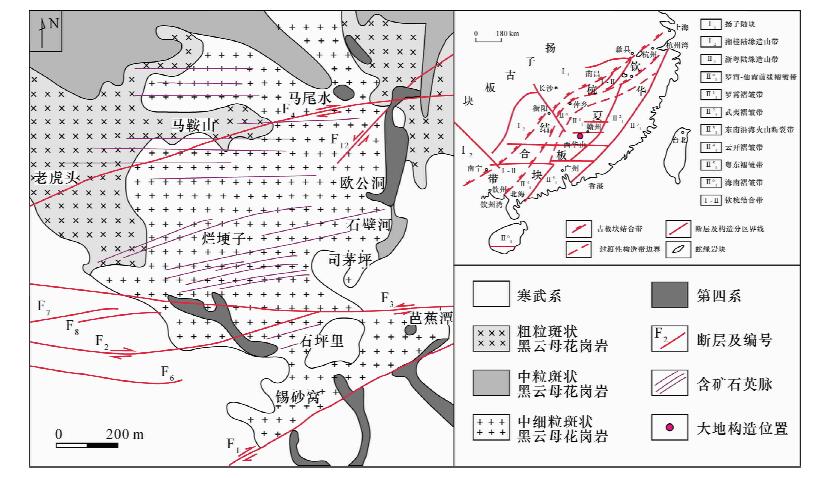
 下载:
下载:
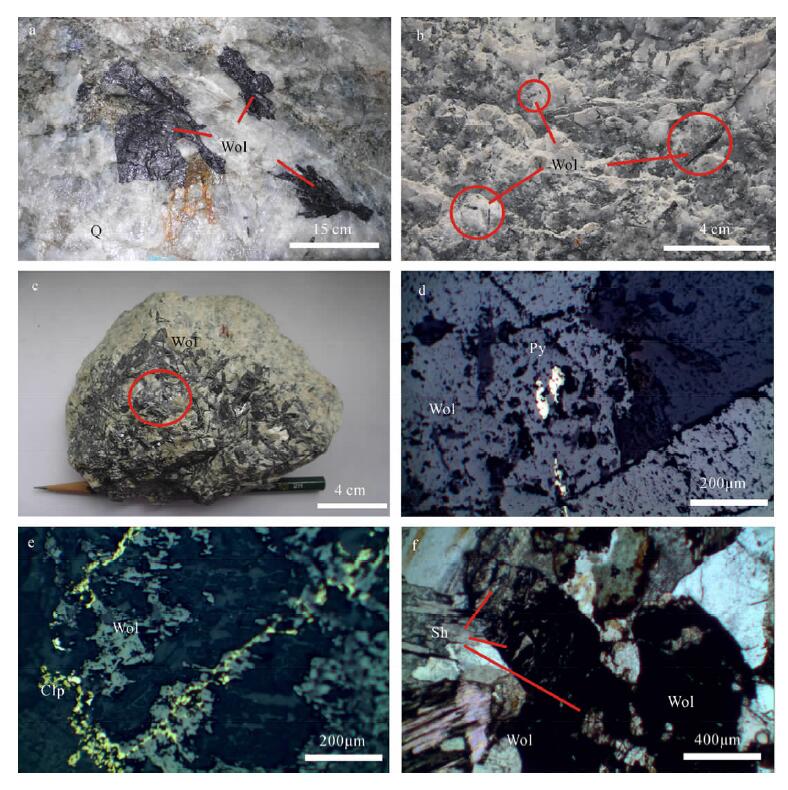
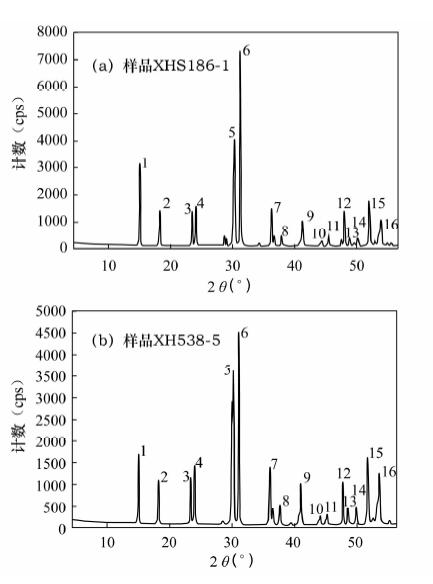
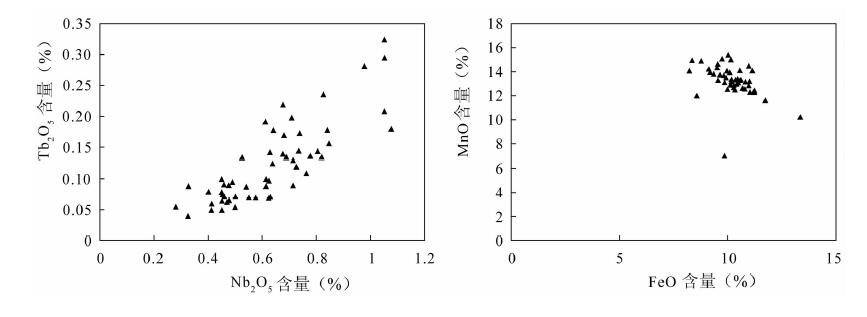
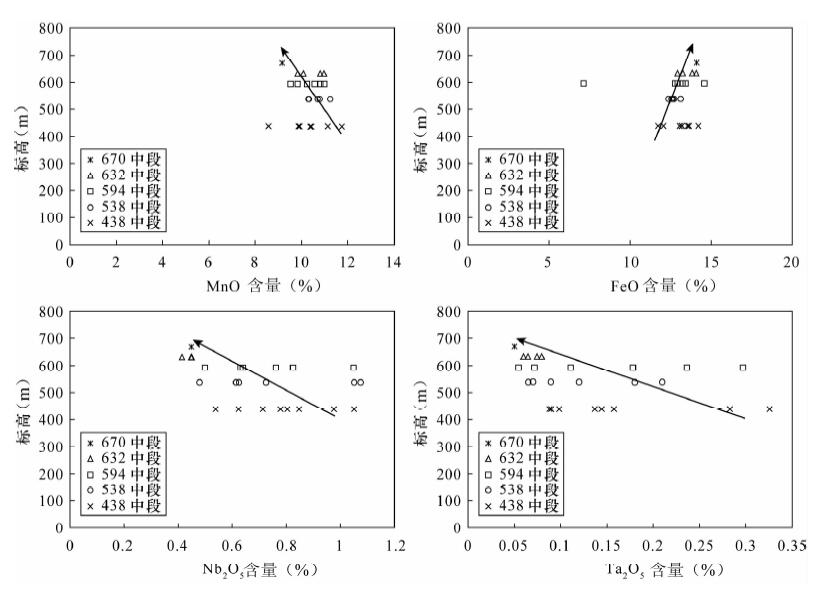
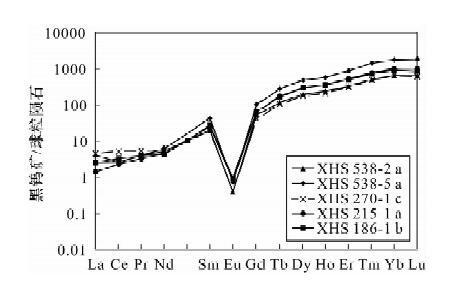
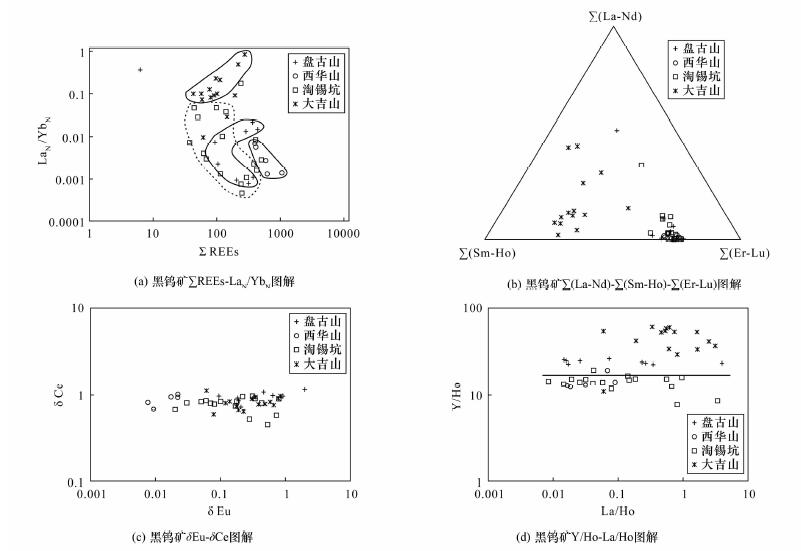
 京公网安备 11010202008159号
京公网安备 11010202008159号